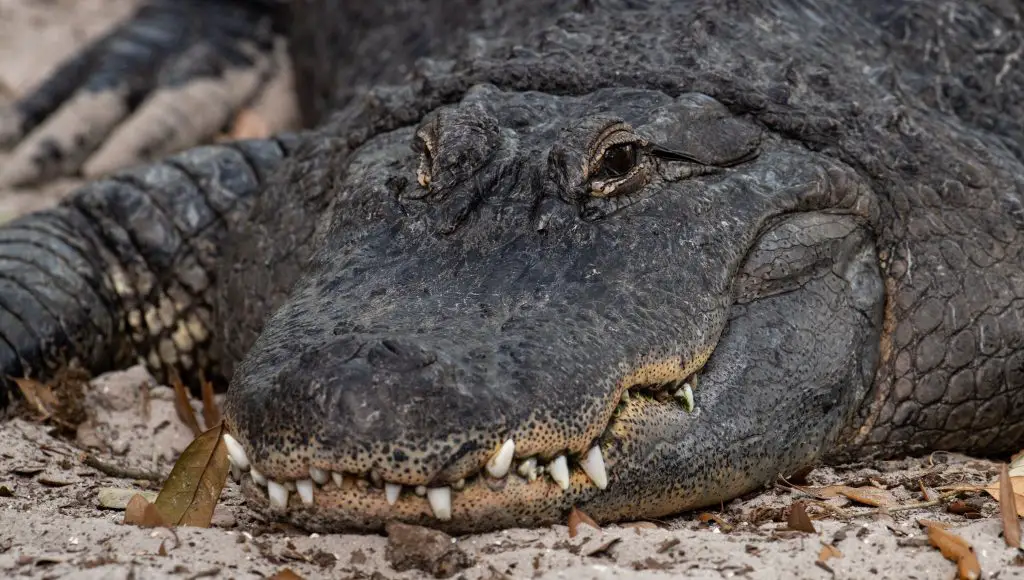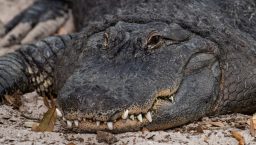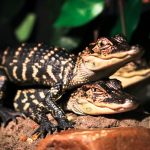Crocodiles have scutes that is similar in appearance to scales – and serve the same function. Scutes are actually horny patches of thickened skin and make the body waterproof to a certain extent .

Do Crocodiles Have Scales Or Skin On Their Backs?
When you think of an archetypal crocodile – say the American Crocodile (Crocodylus acutus) – you think scales. We only normally see crocodiles cruising through the water with their lumpy and scaly backs sticking out of the water – looking like some giant log or floating plant material.
They sometimes even hold or balance bits of wood on their faces to lure in prey.
Anyway – this nobbled skin on their backs is not only great camouflage – but also protects them from the blazing sun while they lay around in lakes and rivers waiting for unsuspecting animals to wander in for a much-needed drink.
If you are getting technical though – the skin on their backs is still skin – it is just covered in a specialized layer of hardened keratin (like fingernails) which we call scales. They aren’t like snake scales though (which overlap) they are on the surface of the skin laid out side by side. This continuing pattern of scales on the skin are called ‘scutes’ and the crocodiles are covered in them from head to toe.
What’s The Difference Between Scales And Scutes?
It isn’t like anyone has ever heard of scutes – but we all know what scales are. This is another reason why it doesn’t really matter that they aren’t called scales. Everyone knows what you mean, but if you want to know the details at a more technical level – here is a quick overview:
Scutes are similar in appearance to scales – and ultimately serve the same function for the animal – they just evolved separately. They are slightly different in origin and make-up – and sit differently depending on the animal. Scutes are actually horny patches of thickened skin and make the body waterproof to a certain extent, allowing the reptiles to live on land (as opposed to amphibians who must stay moist).
Depending on the animal – the scutes can be all sorts of shapes and sizes and grow with the animal. Some of these scutes have a layer of bone underneath them and are called osteoderms. These osteoderms are the lumpy bits on a croc’s back that help them look log-like.
Presumably, in the past, an ancient crocodile was born with a few of these by accident and it gave them a predatory advantage. Passing these now well-known identifying features through the generations. it is now sometimes impossible to actually see a crocodile in the water right in front of you – even though they can be several meters long.
Do Crocodiles Shed Their Skins?
Yes Crocodiles do kind of shed their skin (Scutes). Crocodiles don’t suffer from old age – so they can replace their scales and keep getting bigger every time.
Scutes are molted in pieces throughout the crocodile’s life rather than shed in one whole skin – like with a snake. Reptiles are born as miniature adults and so they start with small scales to fit their small bodies. As they grow – they need bigger skin to cover themselves – so their skin grows with them.
As their skin is horny – in scutes – they can’t stretch as human skin does – they have to replace and regrow each scute one at a time. They do this by shedding the top layer of a scale while growing a new larger one underneath it. They need their scales for protection not only from the sun but also to protect them from the animals they catch, the habitat they live in, and from other crocodiles – so they can’t shed it all at once.
When shedding – they often rub themselves on tree bark or rocks to get the old scutes off and make way for a fresh new skin – a little bit bigger than before. Crocodiles don’t suffer from old age – so they can replace their scales and keep getting bigger every time into eternity or an accident – whichever comes soonest.
Why Do Raccoons Scream? Is it a Form of Communication?
Why do raccoons scream? Is it a form of communication? The raccoon screaming behavior explained. Raccoons scream as a means of communication, particularly when they feel threatened or to establish territory. It helps them express fear, aggression, or mating calls. These vocalizations can be quite loud, eerie, and may startle humans. Understanding this behavior sheds light on raccoon communication methods.
Are Crocodiles Farmed For Their Skin?
A third option is being farmed for your skin. Crocodiles are widely farmed for their tough and beautifully patterned skin.
Some species are more delicately-skinned than others and used for clothing and designer products – and other skins are thicker and more durable so used for sundries and shoes.
Crocodiles prized for their skins need to be kept differently from wild-living individuals to make sure there is no damage to the scutes. The molts also need to be carefully managed to get the best effect on the final product.
There are also many wild-caught crocodiles around the world used for lower quality goods (including food) but they generally produce less usable skin due to natural damage in their natural habitat.










